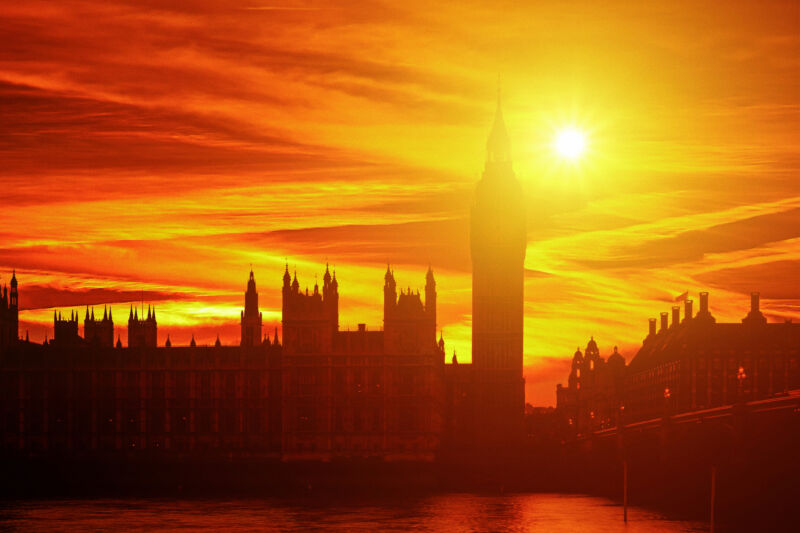
On July 19, 2022, the UK experienced a taste of the weather to come. Temperatures reached 40.3° Celsius—soaring past the previous record by more than one-and-a-half degrees.
Dozens of homes in east London were destroyed by fires, while elsewhere in the country, the heat pushed the power grid close to the point of failure. The Office for National Statistics estimates that there were more than 2,800 excess deaths among over-65s during the summer heat waves of 2022, making it the deadliest year for heat since 2003.

Before the temperatures had even peaked, Friederike Otto was in her office in Imperial College London, getting ready to answer the question that she knew would be thrown at her countless times in the following week: Was climate change to blame?
When an extreme weather event strikes, Otto and her small team of climate scientists—most of them working in their spare time—are the people the world looks toward to tell them whether climate change has made the weather more severe or more likely to be. “I think it’s important to get a more realistic picture of what climate change means,” says Otto, a senior lecturer in climate science at the Grantham Institute for Climate Change and the cofounder of the World Weather Attribution initiative. “For some types of events, like heat waves, climate change is a real game-changer, and we see events that we have never seen before.”
Every week, a contact at the Red Cross sends Otto and her colleagues at World Weather Attribution a list of floods, heat waves, and other extreme weather events across the globe. Often there are six or eight crises listed in the email—far too many for Otto’s small team to tackle—so the scientists narrow their focus to weather that is impacting millions of people, selecting roughly one event every six weeks, from storms in Europe to flooding in Pakistan.
Once the scientists have picked a subject for their analysis, they move fast, digging into historical records and running climate models in order to figure out what role—if any—climate change played in a disaster. The final report is usually published within days or weeks of an extreme weather event. This is a huge departure from the normally glacial pace of academic publishing, where it can take years for a scientific paper to finally end up in a journal, but quick answers are the whole point of World Weather Attribution. By releasing studies while an extreme event is still dominating headlines and political agendas, the scientists fill a void that might otherwise be occupied by climate change denial. In the case of the UK heat wave, World Weather Attribution was ready with its report just nine days after temperatures reached their peak.
The findings revealed the unprecedented scale of the record-breaking temperatures. Otto’s team estimated that climate change had made the UK heat wave at least 10 times more likely, and that in a world without global warming peak temperatures would have been about 2° Celsius lower. The weather was so unusual that, in a world without climate change, it would have been statistically impossible to reach such high temperatures in two out of the three weather stations the scientists studied. In the world of climate attribution science, this is about as close as you get to a smoking gun. “People always want the number, and sometimes you can’t give a very satisfactory number,” Otto says. This time, however, Otto had no shortage of numbers to share with the reporters who were ringing her up.
But attribution science can do a lot more than tell us how climate change influences the weather. Otto wants to use her attribution reports to hold polluters to account for extreme weather events. “We have started to do a lot of work with lawyers, to basically bridge this knowledge gap between what we can say scientifically and what has so far been used in terms of evidence,” she says. With legal cases underway in Germany and Brazil, attribution science is moving into the courtroom.
The beginnings of WWA
Otto cofounded World Weather Attribution in 2014 with the oceanographer Heidi Cullen and climatologist Geert Jan van Oldenborgh. At first, Otto—who has degrees in physics and philosophy—thought that the main role of weather attribution was to untangle the complexity of weather systems to quantify how much climate change was influencing extreme weather. Other scientists had established how to use climate models to attribute weather events to climate change, but no one had tried to use the science to produce rapid reports on recent disasters.
World Weather Attribution’s first real-time study was published in July 2015. It found that a heat wave in Europe earlier that month was almost certainly made more likely thanks to climate change. Other studies followed on floods, storms, and rainfall, each one published within weeks of the disaster. But attribution studies aren’t just about understanding past events—they can help us prepare for the future, Otto says. “I see attribution now as a tool that helps us disentangle drivers of disasters and helps us use extreme events as a lens in society to see where we are vulnerable.”









